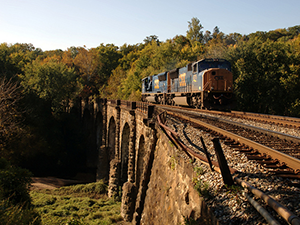
The Thomas Viaduct - A Vital Link
On May 5, 1861, Brigadier General Benjamin F. Butler, under orders from Lieutenant Winfield Scott, occupied Relay, Maryland, with the 6th Massachusetts and 8th New York Regiments (2,080 men) and Major Cook’s battery of Boston Light Artillery. Cannons were immediately placed on hills overlooking the Thomas Viaduct and the B&O Railroad junction. The cannon emplacements on the Baltimore County side were named “Fort Dix” and the emplacements on the Howard County side were “Camp Essex.” The support base was “Camp Relay.”
General Butler then used Relay Junction as a staging ground for a raid on Ellicotts Mills to capture the Ross Winans' Steam Gun, and the occupation of Baltimore's Federal Hill on May 13, 1861, thus securing the city for the Union.
General Butler’s mission was to stop the supply line from Confederate sympathizers in Baltimore to the southern troops at Harpers Ferry. Butler was also to provide a first line of defense against attempts to attack Baltimore or Washington. The Thomas Viaduct and the railroad junction at Relay were strategic points along the B&O Railroad. They provided Washington D.C. with its only direct rail connection to the north and a main link to Harpers Ferry and the west. Relay was also a gateway to the Patapsco Valley, which contained many mills that were manufacturing equipment and textiles vital to the union war effort. If the Confederates destroyed the Thomas Viaduct, rail traffic to the nation’s capital from the north would have been cut off.
Thomas Viaduct was completed in 1835 and is the world's largest multiple arched stone railroad bridge with an arc. The viaduct was named for Philip E. Thomas, the first president of the B&O Railroad. Enter the Avalon Area of Patapsco Valley State Park off U.S. 1 at South Street, just north of Elkridge. Proceed on Park Entrance Road to the Ranger Station. Thomas Viaduct is in view behind contact station. Park in driveway in front of Ranger Station. Note Viaduct interpretive sign at Ranger Station and carefully walk road to examine the Viaduct keeping in mind the danger of the blind curve on the roadway.